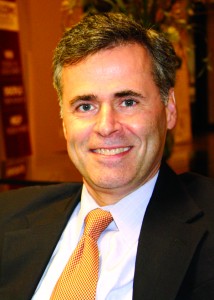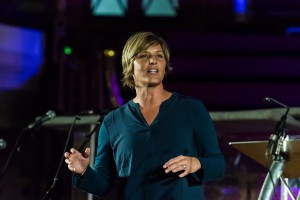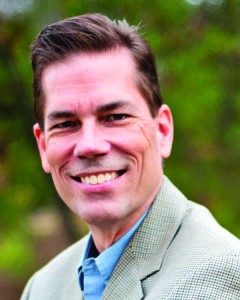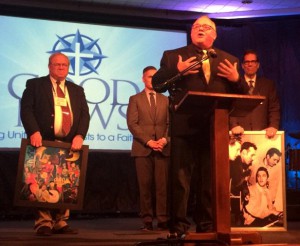![Plunge in Worship Attendance]()
by Steve | Jan 24, 2017 | Jan-Feb 2017, Magazine, Magazine Articles
 By Walter Fenton-
By Walter Fenton-
The United Methodist Church’s General Council on Finance and Administration (GCFA) reported a 2.9 percent decline in weekly worship attendance from 2014 to 2015. Some observers merely shrug when they hear about a 2.9 percent loss. It seems deceptively inconsequential.
The stark truth is that a 2.9 percent decline means a loss of 82,313 worshippers, the largest loss in the denomination’s 48-year history. On average, UM local churches in the U.S. collectively welcomed 2,832,239 to worship services each weekend in 2014. That number dropped to 2,749,926 in 2015.
The figure is considered a key indicator of the health and vitality of the church, and it is an important number for helping the GCFA construct the quadrennial budgets for the general church. Last year, when the GCFA learned that average worship attendance fell 2.6 percent from 2013 to 2014, it revised downward its budget proposals for the 2016 General Conference delegates.
While a 2.9 percent decline from one year to the next does not immediately threaten the church, cumulative drops of two percent or more are cause for grave concern. In four of the last six years the denomination has seen drops above that threshold.
Throughout much of the 1970s, 80s, and 90s, average worship attendance declined, but not precipitously so. While the rate dropped overall, there were years when average worship attendance actually increased. (The last time the denomination registered an increase in worship attendance was 2001, when the figure grew by 1.7 percent. Many church statisticians considered that rise an anomaly due to a resurgent, but brief interest in church attendance shortly after the 9/11 terrorist attacks. The UM Church was not alone in seeing an increase in 2001.)
“Between 1974 and 2002, we lost an average of 4,720 in worship attendance per year,” said Dr. Don House, a professional economist and former chair of GCFA’s Economic Advisory Committee. “But a major shift occurred in 2002. The rate skyrocketed to an annual rate of 52,383 between 2002 and 2012, and now we’ve seen losses of 62,571 (2012-2013), 75,671 (2013-2014), and 82,313 between 2014 and 2015. This is not sustainable.”
Generally, declining rates of worship attendance have a knock-on effect. As local churches see fewer and fewer worshippers, they find it harder to stem their declines. Eventually, they discover they can no longer afford a full-time pastor, which only exacerbates their situations.
More broadly, the denomination then struggles to recruit new pastors, particularly younger ones with families and college debt. People considering full-time ministry justifiably wonder if there would be a local church appointment available that could pay a decent salary with health and pension benefits.
Calculations like this ultimately impact the church’s seminaries in declining enrollments, leading to reduced staffing at the institutions, and even threatening their viability. In short, the drop in worship attendance erodes the very infrastructure many believe is necessary to reverse the downward trend.
In a 2014 report to the GCFA and the Connectional Table, the denomination’s highest administrative body, House warned that the church needed to quickly adopt a credible and metrics driven plan to arrest the plunge in worship attendance. If it failed to do so, he projected that by 2030 the denomination would slide into permanent decline and face collapse by 2050.
When House prepared his report he possessed attendance records through 2013. Based on the figures at hand he projected an annual rate of decline of 1.76 percent, but the numbers from the last three years (2.1, 2.6, and 2.9) are well above that rate.
“If we experience a growing rate of decline, as demonstrated since 2012,” said House, “our window for a turnaround strategy will be shorter than I originally projected. We cannot maintain the connection unless we are able to implement and fund a strategy within the next 14 years.”
All five jurisdictions in the U.S. experienced average worship attendance losses in 2015. The Western jurisdiction led the way with a drop of 3.6 percent followed by the Northeastern (3.5), North Central (3.2), South Central (2.8), and the Southeastern (2.5).
Four of the 56 U.S. annual conferences actually bucked the downward trend with increases in attendance: Yellowstone (9.5 percent), West Virginia (4.3), Dakotas (1.7), and Peninsula-Delaware (1.1).
Conferences with the steepest losses were: Eastern Pennsylvania (7.3 percent), New Mexico (6.8), Susquehanna (5.7), and Dessert Southwest (5.4). Between 2014 and 2015 the Eastern Pennsylvania Annual Conference saw one of its largest and fastest growing local churches exit the denomination.
Various reasons for the decline in attendance have been cited.
There is general agreement that many local churches are located in areas where the general population has been declining for years (e.g., western New York and Pennsylvania, and across the upper Midwest and Great Plains states). When these churches were planted in the 19th century their locations made good sense, but now, due to declining population, they are difficult to sustain. It is also true that UM Church members are an aging population, so some of the decline in average worship attendance is simply due to attrition.
These natural declines are not being offset by local church growth in the major metropolitan areas clustered along the coasts, across the south, and in other urban areas where other denominations and non-denominational churches are either holding their own or seeing increases. For instance, the UM Church has only a few large, growing congregations in the densely populated urban areas of the northeast and the west.
Of the approximately 32,100 local UM churches in the U.S., 76 percent (24,654) average less than 100 in attendance, and nearly 70 percent (16,909) of those actually average less than 50 on Sunday morning. Local congregations below that threshold are often challenged to afford a full-time pastor or to find the resources necessary for a sustained plan of evangelization.
Beyond the reasons cited above, there is considerable debate as to why worship attendance has fallen for the past 14 years straight, and why the rate has accelerated so dramatically in the past five.
Many progressives and some centrists argue the church is woefully out of step with the broader culture, particularly with millennials. They claim the church is actually alienating many people with its stands on social issues, particularly those having to do with sexual ethics and marriage.
Traditionalists and other centrists argue the church has lost its evangelical zeal, and also claim the Council of Bishops’ public failures to maintain the good order of the church has undermined local church effectiveness, sapped the morale of clergy and laity who have come to distrust their leaders, and driven members away from its congregations.
Despite the record loss for the denomination, many local churches continue to thrive, grow, and show signs of health and vitality in the ministries they undertake every day.
“I am confident,” said the Rev. Rob Renfroe, president of Good News, “that when we United Methodists are at our best, we have a message that will win people to Christ, transform lives, and send out dedicated disciples to the last, the least, and the lost. I’ve seen it happen over and over again in many different places. But given the crisis we are facing, we must be prepared, going forward, to consider bold ideas and implement major structural changes.”
Walter Fenton is a United Methodist clergy person and an analyst for Good News.

by Steve | Jan 24, 2017 | Jan-Feb 2017, Magazine, Magazine Articles

Photo provided by danielstrickland.com.
By Courtney Lott-
Chaos gets a bad rap. We cling to order and calm, presenting nice, tidy images of ourselves worthy of Facebook and Instagram and Pinterest. Behind them we hide, loathe to let others see what’s on the other side of the curtain. Yet, it’s often when things are upturned, broken, and exposed that we experience true growth and change. In her book, A Beautiful Mess, author Danielle Strickland suggests that God actually uses chaos to transform our lives and draw us closer to him.
A major in The Salvation Army in Los Angeles and an Ambassador for the global anti-trafficking campaign Stop the Traffik, Strickland knows how messy life can get better than most. Through her own encounter with the Lord and her ministry to brothels, she is intensely familiar with the ugly, dirty chaos of this world. Rather than run from it, Strickland chooses to embrace it.
“My experience of life with God is messy,” she says in her introduction. “It’s a mix of failure and success, courage and fear, faith and doubt. It’s-well, a beautiful mess…It’s beautiful because it’s a witness to the creative design of God’s love in the here and now of our lives. My life doesn’t look anything like it once did…I’ve been re-created by a designer who loves to recycle.”
This serves as a thesis statement for the rest of the book. What follows are stories of God working through the chaos of people’s lives to accomplish his good purposes. Interwoven between these is Strickland’s ongoing exhortation to embrace the messes we encounter rather than try to hide or cover them up.
One of the strongest points of A Beautiful Mess is the probing questions Strickland asks, and she starts right out of the gate in the first chapter. “What if the pursuit of order has created a love of the status quo and has removed the passion for justice? What if we have made a friend of comfort instead of change and as a result removed ourselves from the responsibility that demands that we fight for change to happen?”
Throughout the book, Strickland continues to prod the reader with these types of questions. They cause the audience to stop, to think, to reconsider. In harmony with her premise, this upends the nice little boxes we might have stacked neatly in our minds, creating the kind of discomfort that challenges long held beliefs. Somewhat ironically, she also adds orderly numbered questions at the end of each chapter as well, making it easy to use in a discussion group.
Chaos, Strickland says, is necessary to create something; and, in fact, an over devotion to order actually leads to breakdown. She writes, “If instead of clinging desperately to order we allow God to set the priorities, then the divine can and does speak a different kind of order into existence that promises permanent and lasting meaning for us personally and in the work that we are a part of.”
It can feel like chaos to give up control, to wait on the Lord’s voice and His timing, and it requires a healthy dose of courage. According to Strickland, however, it is only when we wrench our grip from the wheel and hand it over to the Lord that we can enter real life. Of the many stories the author tells in A Beautiful Mess, one of the most profound is a story that starts with an affair. After catching her husband being unfaithful, a friend of Strickland’s found her entire life turned upside down. Yet amidst the chaos and mess, she sought out the Lord. It was then that he led her to Africa. From what seemed to be a dead end, God used this woman to serve widows and orphans in desperate need of her gifts. Stories like this remind the audience that there is a bigger picture; that on the other side of messy suffering is a new path, renewed life.
“What is emerging from her chaos is something so beautiful and rich and different than her life would have been,” writes Strickland. “She now has the ability to look back and see that even the chaos was an opportunity to see God’s order emerge in her life. Even the darkness helped her [move] toward God’s Divine Order for her life.”
Chaos also often uncovers the truth we hide from, Strickland says. An experience in Russia just after the collapse of the Soviet Union taught her about the failures of scientific and orderly modernity to answer the deep internal questions. Strickland learned from her Russian translator, Olga, that the government had fed the people many lies to make them believe that things were good. Everything appeared neat and tidy on the outside, but the eventual collapse made it evident that this was not true. The citizens of the Soviet Union chose to believe the lies they were fed until the chaos forced them to see the truth.
Strickland writes, “It is sometimes simply easier to believe that things are ordered, reasonable, predictable, and completely under our control. But the reality of our world is that it is unpredictable, often random and unreasonable, chaotic and completely out of our control. And that’s when modernity’s promises run empty and its progress reports run dry.”
This is not limited to secular governments, Strickland says. The church also often trips into the same pitfalls, settling for “whitewashed tombs” rather than accepting the kind of chaos that asks hard questions and risks failure. “The truth would rather embrace honest chaos than continue to whitewash the tombs of our culture so we die looking good,” Strickland writes. “It’s really about allowing chaos to show a bit, and even enjoy it.”
Finally, Strickland says that chaos can actually bring light to darkness and allow us to join with God to create things. Injustice casts a pall over our world and when we seek to bring an end to it, a mess often ensues. As uncomfortable as this might be, it is necessary if we wish to make any kind of progress, if we want to join God in bringing his kingdom here on earth as it is in heaven. Strickland describes it beautifully. “We need a ‘curtains being pulled back in the morning’ moment where light or revelation floods in.” If we’re standing still in fear of the chaos, she says, we will never experience this kind of moment.
Strickland concludes A Beautiful Mess by encouraging the reader to create a timeline in which to track times of chaos within one’s life. This, she says, will help identify the process of God’s “Divine Order”, of how he uses the mess to bring us into his light. “We get to be a part of this incredible work of beauty – this art called life,” she writes. “And then we rest. We step back and breathe in the beauty of a love-filled, creative God. A God who uses every shade and vibrancy of colour to re-create our lives in ways we could never have imagined or dreamed. We get to stop working, and celebrate the incredible truth that we are, all of us, a beautiful mess.”
Courtney Lott is the editorial assistant at Good News.

by Steve | Jan 24, 2017 | Jan-Feb 2017, Magazine, Magazine Articles
 By Thomas Lambrecht-
By Thomas Lambrecht-
After an agonizingly long period of formation, the Bishops’ Commission on a Way Forward for The United Methodist Church began its work in December. The commission consists of 32 members reflecting the broad geographical, ethnic, and theological diversity within United Methodism.
The commission is being moderated by three bishops, Sandra Steiner Ball (West Virginia), Kenneth Carter (Florida), and David Yemba (Democratic Republic of Congo). The members of the commission include eight bishops (not counting the moderators), 13 clergy (two deacons and 11 elders), and 11 laity. Geographically, one-third of the commission is from outside the United States (seven from Africa, two each from Europe and the Philippines).
The commission’s deliberations began with a conference call in mid-December. Roughly a half-dozen face-to-face meetings are tentatively planned in 2017, with more in 2018. The investment of time will be significant, with meetings planned to last 2-1/2 to 3-1/2 days each. It is expected that commissioners will do assigned reading and other background work in between meetings.
The purpose of the commission was set forth in the bishops’ statement to the 2016 General Conference outlining their call to find a new way forward in unity. The commission is charged with “discerning and proposing a way forward through the present impasse related to human sexuality and the consequent questions about unity and covenant” (October 24 press release). Highlights of that call include:
• To “seek a way forward for profound unity on human sexuality and other matters”
• To consider a way for a “deep unity [that] allows for a variety of expressions to co-exist in one church”
• “To lead the church toward new behaviors, a new way of being and new forms and structures which allow a unity of our mission of ‘making disciples of Jesus Christ for the transformation of the world’ while allowing for differing expressions as a global church”
• To deal with the subject of human sexuality, all the legislation regarding sexuality that was referred by the 2016 General Conference to this commission, and “to develop a complete examination and possible revision of every paragraph in our Book of Discipline regarding human sexuality.” Many assume that this means the commission will be looking for ways to delete or weaken the church’s paragraphs on sexuality. But this purpose could just as easily mean a strengthening, clarifying, and restating of the church’s long-standing teaching on sexuality and marriage. In any case, revisions are “possible,” not mandated.
The bishops, particularly the moderators, have committed to regularly communicate with the church about the work of the commission. They will issue statements monthly on the commission’s progress, which reports began last October even before the naming of the commission.
The commission faces some steep challenges. People from all over the world, speaking a variety of languages, and coming from diverse personal backgrounds, will need to forge relationships that can lead to trust and open communication. We will need to address a topic that is fraught with deep emotional and personal impact. We will need to attempt to bridge a theological divide in our church that is more like a chasm. We will need to consider the impact of the commission’s recommendations on every single United Methodist, every congregation, and multiple regions and cultures around the world.
The commission comes into being at a time when significant parts of the U.S. church have determined to live in violation of the requirements of our Book of Discipline as established by the worldwide church in General Conference. That continued disobedience endangers the church’s unity and can influence the very nature of what it means to be United Methodist. Advocates for such disobedience are members of the commission, as are persons who staunchly defend the church’s current teachings and requirements around sexuality, marriage, and ordination. How will these differences be bridged?
The commission’s work also takes place at the same time that other significant initiatives are moving forward in the church. One is the effort to delineate a global Book of Discipline that all United Methodists must live by, while allowing annual conferences and perhaps jurisdictions to adapt other parts of the Discipline to their local context. A second initiative is the development of entirely new Social Principles that are globally applicable and couched in more understandable language. These and other initiatives will need to be coordinated with the commission’s work, so that the recommendations of all groups will be coherent with each other.
The bishops of the church are coordinating a parallel effort in the grassroots of the church to engage in dialogue around the topic of human sexuality and its implications for the unity of the church.
Given the broad scope and significance of the commission’s work and the challenges it faces, the bishops have requested that prayer be a central focus of the commissioners, as well as the general church. Please remember to regularly lift up the commissioners and our work, as we seek a Christ-honoring way forward. Pray for God’s grace, not only upon the deliberations of the commission, but upon the commissioners’ lives, as we sacrifice significant time away from family, work, and ministry and experience the demands of international travel in order to devote ourselves to this important task.
Thomas Lambrecht is a United Methodist clergyperson, vice president of Good News, and a member of the Bishops’ Commission on a Way Forward for The United Methodist Church.

by Steve | Jan 24, 2017 | Jan-Feb 2017, Magazine, Magazine Articles

Mr. Steve Beard,
Editor in Chief of Good News
While gathering in Memphis, Tennessee, the Good News Board of Directors celebrated the 25th anniversary of Mr. Steve Beard as columnist and editor in chief of Good News – at the helm for more than 150 issues of the independent United Methodist magazine.
In commenting on the anniversary, the Rev. Walter Fenton, a colleague at Good News, noted that Beard’s wide-ranging journalistic interests swung from John Wesley to Bono, Johnny Cash, and Mahalia Jackson – and passionately focused on the plight of martyrs and persecuted believers around the globe and the marginalized in our own society.
“You’re always wondering about how we as a church can find ways to be more compassionate, gracious, and just simply kind and decent to the lost and lonely in this world that too many of us hardly even notice,” concluded Fenton.
The board of directors presented Beard with a framed picture of the “Million Dollar Quartet” – Elvis Presley, Johnny Cash, Carl Perkins, and Jerry Lewis in the studio of Sun Records in Memphis, as well as original art from contemporary folk artist Chris Taylor.
Prior to his retirement, the Rev. Dr. James V. Heidinger II, president emeritus of Good News, worked with Beard for 18 years. “I remember a great picture on one of Steve’s office walls of him in a tuxedo, talking with the late William F. Buckley Jr. at a Washington D.C. reception,” recalled Heidinger. “It always reminded me of the cultural adjustment Steve had to make in coming to our former offices in Wilmore, Kentucky.”
“But how fortunate for all of us that Steve did come! And that he stayed,” continued Heidinger. “He worked himself ragged giving Good News a first-rate publication, issue after issue. It has been your calling for quarter of a century, and you have done it splendidly!”
“You are gifted professional, a skilled craftsman, and a person of great integrity,” Heidinger concluded. “You have amazingly good instincts about how we can and should relate to a church struggling for its soul…. Congratulations on this very significant milestone.”
– Good News Media Service

by Steve | Jan 24, 2017 | Jan-Feb 2017, Magazine, Magazine Articles
By Steve Beard-
As we pulled together this celebratory issue of Good News, we were confronted with the horrific news of the brutal murders of brothers and sisters in the faith.
Twenty-five people died and 49 more were injured when a bomb went off on the chapel on the grounds of St. Mark’s Coptic Orthodox Cathedral, the seat of the Egyptian Orthodox Church. In your prayers, we invite you to join us in remembering the precious women and children – the targets of this bombing – who were victims of this terrorism.
The description from Reuters is heartbreaking: “The chapel’s floor was covered in debris from shattered windows, its wooden pews blasted apart, its pillars blackened. Here and there lay abandoned shoes and sticky patches of blood.”
“As soon as the priest called us to prepare for prayer, the explosion happened,” said Emad Shoukry, who was inside when the blast took place. “The explosion shook the place … the dust covered the hall and I was looking for the door, although I couldn’t see anything … I managed to leave in the middle of screams and there were a lot of people thrown on the ground.”
“Rejoice with those who rejoice, weep with those who weep,” St. Paul instructs. Our prayers are with the families of the victims. Lord, in your mercy, hear our prayers.
Steve Beard is the editor of Good News.





